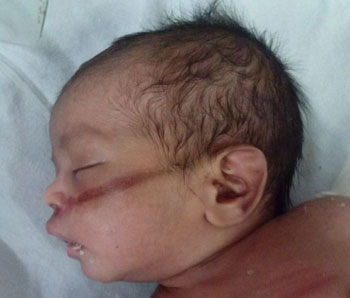|
|
|
Indian Pediatr 2015;52: 161 |
 |
Unique Injury due to Reuse of CPAP Cannula
|
|
Ashish Jain and Veeraraja B Sathenahalli
Division of Neonatology, Hindu Rao Hospital, Delhi.
India.
Email: [email protected]
|
|
Continuous positive airway pressure (CPAP) is used
widely as a non-invasive modality of respiratory support in neonates
[1]. However, the most important challenge in optimal use of the CPAP is
a safe and comfortable interface; every interface causes injury to a
variable extent [2]. The RAM cannula is now being widely used as this is
simple to apply and has less potential of injury compared to other
interfaces. Reuse of these cannulas is not recommended but in
resource-limited settings, these are being reused after disinfection
with routinely used disinfectants like glutaraldehyde.
We report a unique contact burn injury with use of
reused RAM cannula in our hospital. A preterm baby, who was having
respiratory distress at birth, was administered CPAP using RAM cannula.
She developed linear contact burn injury on day 2 of use of the cannula
(Fig. 1). On investigation and analysis, it was attributed
to chemical burn by 2.5% glutaraldehyde used for the chemical
disinfection of the cannula. The retained chemical caused a contact
chemical dermatitis. Similar reports are available for other instruments
like transesophageal echocardiography probes [3].
 |
|
Fig. 1 Linear injury mark over face.
(See color image at website)
|
As the reuse of these cannulas is widely practiced in
the resource-constrained settings, due care should be taken to use the
correct dilution of the chemical disinfectant, and the same should be
thoroughly washed with sterile water for removal of the residual
chemical before applying cannula to the infant. Ideally, these cannulas
should not be reused.
References
1. Morley CJ, Davis PG, Doyle LW, Brion LP, Hascoet
JM, Carlin JB. Nasal CPAP or intubation at birth for very preterm
infants. N Engl J Med. 2008;358:700-8.
2. Yong SC, Chen SJ, Boo NY. Nasal trauma
associated with nasal prong versus nasal mask during continuous positive
airway pressure treatment in very low birth infants. Arch Dis Child
Fetal Neonatal Ed. 2005;90.F480-3.
3. Steven GV, Vikram SK, Robert J. O’Connell.
Chemical burn injury secondary to intraoperative transesophageal
echocardiography. Anesth Analg. 2003;97:1260-1.
|
|
|
 |
|

